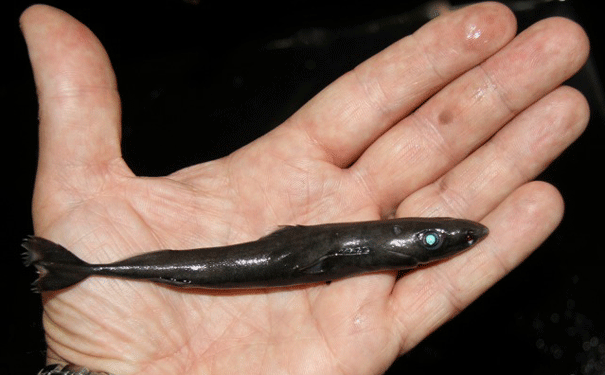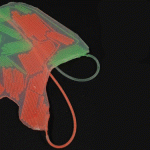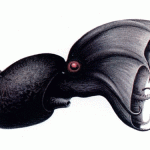
Small-eye pigmy sharks' derbellies are covered in tiny, light-emitting photophores that are able to fill their revealing silhouettes. Image: © Dr J. Mallefet / Dr J.Claes FNRS/ UCL
Small-eye pigmy sharks’ bellies shine to disguise them from predators.
Found in water 150 to 2,000 meters deep near Japan, the Philippines and Australia, the small-eye pigmy shark (Squaliolus aliae) reaches only 22 centimeters, making it one of the smallest shark species in the world. Silhouetted against weak light penetrating from the surface, these tiny sharks should be easy bait for predators approaching from below.
Evolution has given these sharks a handy advantage — their underbellies are covered in tiny, light-emitting photophores that are able to fill their revealing silhouettes. This technique is similarly used by other species such as the velvet lantern belly shark (Etmopterus spinax), who also use this luminous tactic for communication. Scientists Julien Claes from Université Catholique de Louvain, Belgium, and colleague Jérôme Mallefet wanted to discover whether the two shark species developed bioluminescence from the same origin, or developed the ability independently.
After teaming up with scientist Hsuan-Ching Ho from the National Dong Hwa University, Taiwan, the scientists trawled for the shark off the Taiwanese coast. By injecting a range of different substances into samples of the sharks’ skin back in the lab, the scientists observed that the hormone melatonin was able to make the pigmy sharks’ skin glow within 5 to 15 seconds after stimulation. However, when injected with prolactin — the hormone which stimulates 30-minute bursts of light in lantern sharks — it dimmed the pigmy sharks’ glow.
This led the scientists’ to conclude that rather than use bioluminescence for communication, as the lantern shark does, the small-eye pigmy shark uses it purely for camouflage.

The small-eye pigmy shark reaches only 22 centimeters, making it one of the smallest shark species in the world. Image: © Dr J. Mallefet / Dr J.Claes FNRS/UCL
“Contrary to the pygmy shark that has a homogeneous ventral luminous pattern perfectly suited for camouflage, the lantern shark harbours patches of high photophore density on its fins, flanks and tail that produce a brighter luminescence than the ventral part of the shark which is used for camouflage,” says Claes. “This is probably used in intraspecific behaviours such as mating, schooling and group hunting.”
This study suggests the pygmy shark is the missing link in the evolution of bioluminescence in sharks. The shark luminescence control mechanism is believed to have evolved from the crypsis mechanism of shallow water sharks, which involves skin pigmented cells controlled by different hormones, including melatonin and prolactin. It is therefore likely that the control of shark photophores has evolved from the crypsis mechanism of shallow water sharks, no longer needed in the permanent darkness of the deepsea where luminous sharks live.
Claes is now involved in a study of the visual systems of pygmy sharks and lantern sharks in order to see if they show adaptations linked to their luminescence capability. Additionally, he is trying to determine the factors that shape the expression of luminescence in sharks by investigating a number of species that inhabit different environments and harbour different lifestyles.
Source: Journal of Experimental Biology






